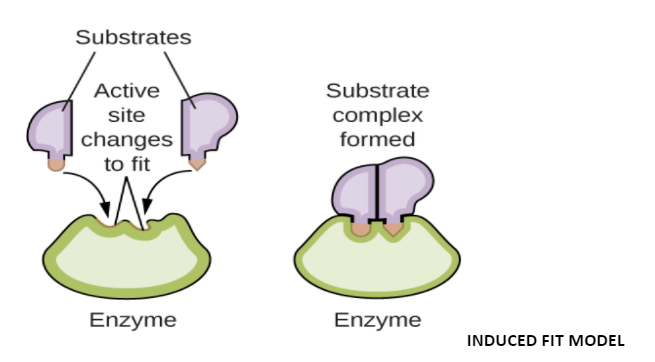
What does induced fit mean?
Answer
400.5k+ views
Hint: As the substrate molecules are comparatively much smaller than the enzyme molecules, there should be some specific regions or sites on the enzyme for binding with the substrate. Such sites of attachment are variously called ‘active sites’ or ‘catalytic sites’ or ‘substrate sites’.
Complete Answer:
To explain the enzyme properties more efficiently, Daniel E. Koshland in 1858, modified the Fischer model. Koshland assumed that the enzyme molecule doesn’t regain its original shape and structure but the contact of the substrate induces some geometrical changes in the enzyme’s molecule active site.
Then, the enzyme molecule is made to fit completely the configuration and substrate’s active sites. At the same time, other amino acids may become more buried in the interior of the molecule. Koshland’s hypothesis has recently been confirmed by Lipscomb.
Now, discuss the Induced Fit Model.
According to this theory, the enzyme’s active site has two regions- buttressing and catalytic. The first region or buttressing region holds the substrate at a correct position while the other region or catalytic region weakens the substrate bonds by electrophilic or nucleophilic forces. When the substrate binds to the first (buttressing) region, the active site of the enzyme undergoes geometrical changes to bring the second (catalytic) region opposite to substrate bonds and this initiates the reaction.

Note:
In this the hydrophobic and charged groups both are involved in substrate binding. A phosphoserine and the –SH group of cysteine residue are involved in catalysis. Other amino acid residues that are not involved in either substrate binding or catalysis are lysine and methionine.
Complete Answer:
To explain the enzyme properties more efficiently, Daniel E. Koshland in 1858, modified the Fischer model. Koshland assumed that the enzyme molecule doesn’t regain its original shape and structure but the contact of the substrate induces some geometrical changes in the enzyme’s molecule active site.
Then, the enzyme molecule is made to fit completely the configuration and substrate’s active sites. At the same time, other amino acids may become more buried in the interior of the molecule. Koshland’s hypothesis has recently been confirmed by Lipscomb.
Now, discuss the Induced Fit Model.
According to this theory, the enzyme’s active site has two regions- buttressing and catalytic. The first region or buttressing region holds the substrate at a correct position while the other region or catalytic region weakens the substrate bonds by electrophilic or nucleophilic forces. When the substrate binds to the first (buttressing) region, the active site of the enzyme undergoes geometrical changes to bring the second (catalytic) region opposite to substrate bonds and this initiates the reaction.

Note:
In this the hydrophobic and charged groups both are involved in substrate binding. A phosphoserine and the –SH group of cysteine residue are involved in catalysis. Other amino acid residues that are not involved in either substrate binding or catalysis are lysine and methionine.
Recently Updated Pages
Master Class 9 General Knowledge: Engaging Questions & Answers for Success

Master Class 9 English: Engaging Questions & Answers for Success

Master Class 9 Science: Engaging Questions & Answers for Success

Master Class 9 Social Science: Engaging Questions & Answers for Success

Master Class 9 Maths: Engaging Questions & Answers for Success

Class 9 Question and Answer - Your Ultimate Solutions Guide

Trending doubts
State and prove Bernoullis theorem class 11 physics CBSE

What are Quantum numbers Explain the quantum number class 11 chemistry CBSE

Write the differences between monocot plants and dicot class 11 biology CBSE

Who built the Grand Trunk Road AChandragupta Maurya class 11 social science CBSE

1 ton equals to A 100 kg B 1000 kg C 10 kg D 10000 class 11 physics CBSE

State the laws of reflection of light




